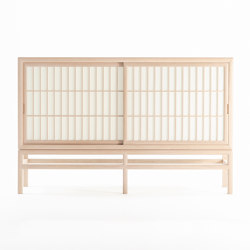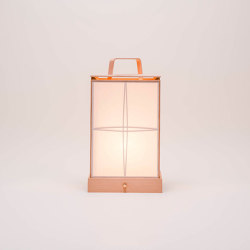andon
Floor lights from Time & Style
Product description
W213×D213×H385;Plain
Concept
A long time ago, I stayed at a tranquil ryokan inn. I noticed an andon lamp in the corner of the room when a candle was lit in the room at dusk. The softness of the light filtered through the Japanese paper of the andon lamp was therapeutic. Although paper lanterns represent the image of Japanese lighting, the andon lamp was a standard light source for the Japanese around the Edo period. As a light source for everyday life, the andon lamp played a central role among the daily necessities.
We tried to figure out how we could bring the traditional Japanese lamps into modern life. Even so, nothing is so difficult as replacing long-held traditions with what exists today because of the traditional rules of format, traditional practices, and fundamental design and materials. In order to create something new that fits our time without departing from these rules, it involves the need to start by recreating the old tradition and design while firmly adhering to the original materials. We thought it was impossible to create a new design that inherits Japanese heritage without satisfying these conditions.
Tokaki is a generic term for andon lamps and lanterns using canola oil and candles. The name, tokaki, has Japanese elements and a sentimental sound. Our goal was a modern version of the andon lamp that achieves an appearance suitable for the name tokaki. There were several key elements in producing the andon lamp. One way was to use handmade Japanese paper representing the essence of tradition to deliver a soft light for poetic shadows in the room. The making of Mino washi ranges from machine-made to handmade throughout the process. Because we wanted the andon to remain true to the tradition of Mino washi, we selected Japanese paper crafted by a skilled artisan. We asked Sawaki from Corsoyard, a specialist, to create Mino washi for our products. By using the highest grade Nasu Kozo fibers as the raw ingredients of washi and an enormous amount of time for the multiple processes, he creates beautiful Japanese paper. The illumination of fire from the canola oil and candle is as small as one-fiftieth of modem lighting.
To recreate flame filtered through washi, the lamp has a dimmed conventional filament lightbulb that reduces the amount of light. The andon lamp’s filament light is achieved by replicating a faint red flame as seen just before diminishing, which was an essential element. Although our attempt goes against the current trend, which calls for rechargeable portable light and lower power consumption, a light dimmer controls the filament in the lightbulb to adjust the brightness of andon lamp. The main idea was to create soft, warm light filtered through washi like a flame. By adjusting the light for the area and purpose of use, we gave priority to the lamp as a reading light or as indirect lighting, as well as for the entrance, hallway, and bedside. Second, we wanted a wood andon lamp to retain the modern presence of Time & Style. Of the different types of andon lamps found in a number of antique shops, we picked wood as the material to use, although andon lamps with iron frames, such as Nagoya andon, are also fascinating. Solid wood was the best material because it blends well with modern living space yet offers a natural appearance. Andon lamps originally had a simple structure without any space for storing a power cable and dimmer. An exposed power cable, socket, and dimmer do not make a beautiful andon. To solve this challenge, the dimmer was set inside the approx. 30mm bottom of a two-leg andon. A dimmer is placed inside the stand by shaving solid Japanese cedar by hand to create the space for the dimmer without any gaps. In addition, 10 by 10 mm cedar sticks support the fire box and the main body from the stand for a lightbulb socket. Inside the 10 mm wooden sticks is a path for cables, and solid cedar wood covers the cables from the top to hide all the cables. By following the tradition of andon made by ancient carpenters, the surface of solid Japanese cedar is carefully planed using traditional methods and no new materials, hardware, or petroleum glue. All the processes are finished by hand to breathe life into this andon, which honors its legacy. Although the work of carpenters requires great care whereas modern manufacturing puts priority on efficiency, our goal was to add greater value. Perhaps, the woodwork increases in sophistication and beauty over several decades to a century. This delicate, elegant work of art was created by two skilled carpenters, a father and a son. This andon could not be completed without them. The framework was thinned to the utmost. The delicate lines of cedar overlapped with handmade washi help reduce any heaviness in the overall presence. We believe the andon naturally matches any modern living space. Our hope is that the light from the andon gives off a refreshing, modern ambience of Japan, instead of a nostalgic impression.
We tried to figure out how we could bring the traditional Japanese lamps into modern life. Even so, nothing is so difficult as replacing long-held traditions with what exists today because of the traditional rules of format, traditional practices, and fundamental design and materials. In order to create something new that fits our time without departing from these rules, it involves the need to start by recreating the old tradition and design while firmly adhering to the original materials. We thought it was impossible to create a new design that inherits Japanese heritage without satisfying these conditions.
Tokaki is a generic term for andon lamps and lanterns using canola oil and candles. The name, tokaki, has Japanese elements and a sentimental sound. Our goal was a modern version of the andon lamp that achieves an appearance suitable for the name tokaki. There were several key elements in producing the andon lamp. One way was to use handmade Japanese paper representing the essence of tradition to deliver a soft light for poetic shadows in the room. The making of Mino washi ranges from machine-made to handmade throughout the process. Because we wanted the andon to remain true to the tradition of Mino washi, we selected Japanese paper crafted by a skilled artisan. We asked Sawaki from Corsoyard, a specialist, to create Mino washi for our products. By using the highest grade Nasu Kozo fibers as the raw ingredients of washi and an enormous amount of time for the multiple processes, he creates beautiful Japanese paper. The illumination of fire from the canola oil and candle is as small as one-fiftieth of modem lighting.
To recreate flame filtered through washi, the lamp has a dimmed conventional filament lightbulb that reduces the amount of light. The andon lamp’s filament light is achieved by replicating a faint red flame as seen just before diminishing, which was an essential element. Although our attempt goes against the current trend, which calls for rechargeable portable light and lower power consumption, a light dimmer controls the filament in the lightbulb to adjust the brightness of andon lamp. The main idea was to create soft, warm light filtered through washi like a flame. By adjusting the light for the area and purpose of use, we gave priority to the lamp as a reading light or as indirect lighting, as well as for the entrance, hallway, and bedside. Second, we wanted a wood andon lamp to retain the modern presence of Time & Style. Of the different types of andon lamps found in a number of antique shops, we picked wood as the material to use, although andon lamps with iron frames, such as Nagoya andon, are also fascinating. Solid wood was the best material because it blends well with modern living space yet offers a natural appearance. Andon lamps originally had a simple structure without any space for storing a power cable and dimmer. An exposed power cable, socket, and dimmer do not make a beautiful andon. To solve this challenge, the dimmer was set inside the approx. 30mm bottom of a two-leg andon. A dimmer is placed inside the stand by shaving solid Japanese cedar by hand to create the space for the dimmer without any gaps. In addition, 10 by 10 mm cedar sticks support the fire box and the main body from the stand for a lightbulb socket. Inside the 10 mm wooden sticks is a path for cables, and solid cedar wood covers the cables from the top to hide all the cables. By following the tradition of andon made by ancient carpenters, the surface of solid Japanese cedar is carefully planed using traditional methods and no new materials, hardware, or petroleum glue. All the processes are finished by hand to breathe life into this andon, which honors its legacy. Although the work of carpenters requires great care whereas modern manufacturing puts priority on efficiency, our goal was to add greater value. Perhaps, the woodwork increases in sophistication and beauty over several decades to a century. This delicate, elegant work of art was created by two skilled carpenters, a father and a son. This andon could not be completed without them. The framework was thinned to the utmost. The delicate lines of cedar overlapped with handmade washi help reduce any heaviness in the overall presence. We believe the andon naturally matches any modern living space. Our hope is that the light from the andon gives off a refreshing, modern ambience of Japan, instead of a nostalgic impression.
More about this product
Part of the collection
LIGHT.
Manufacturer
Time & Style
Family
andon
Architonic ID
20085894
Order number
AN-013
Year of Launch
2016
More products from andon family
Downloads
Manufacturer’s Catalogues
Related Projects
Contact information
Address
4-27-15.Minamiaoyama.Minato-ku, 107-062 Tokyo Japan
Get more information
Sign in to your Architonic account to have your contact details filled out automatically for each request.
Where to buy this product

More from
Time & StyleContact information
Address
4-27-15.Minamiaoyama.Minato-ku, 107-062 Tokyo Japan
Where to buy this product



